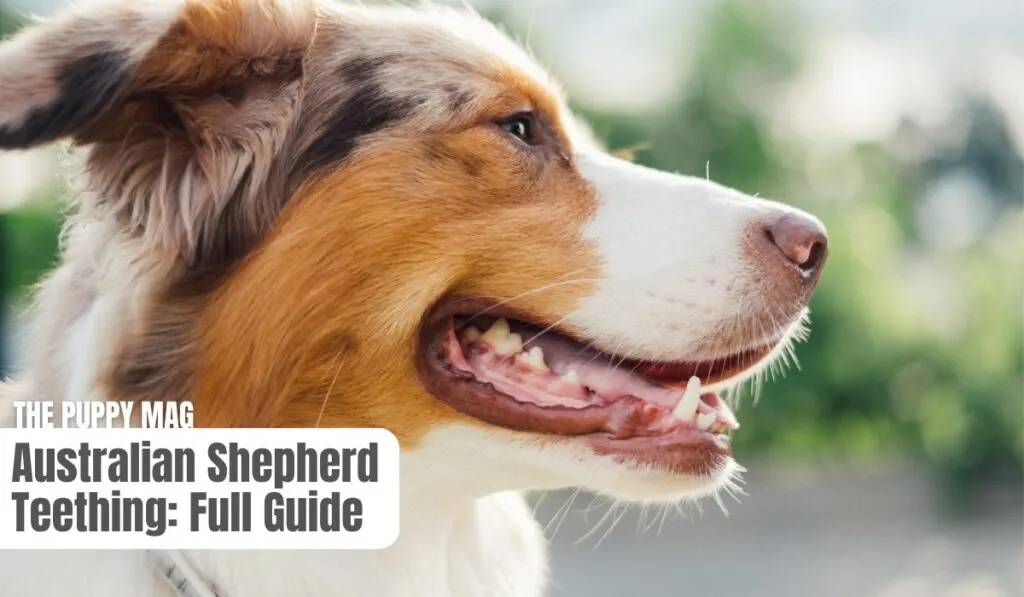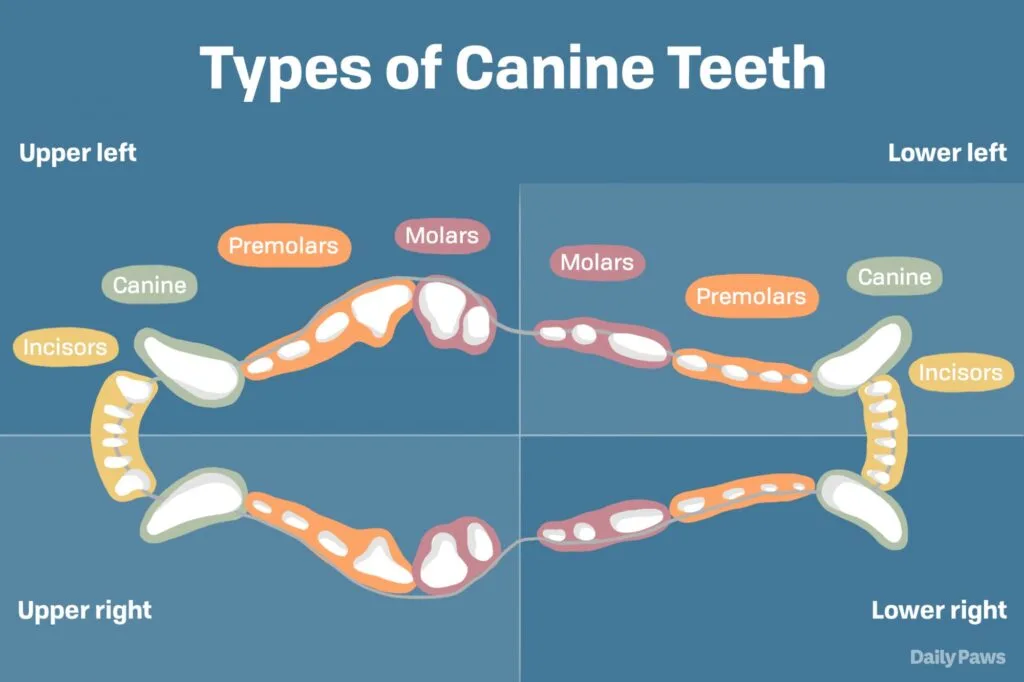As your adorable Aussie pup starts developing teeth, it’s crucial to understand what this process entails, when it begins, and how you can support your pup during this period.
With the right advice and tips, teething doesn’t have to be so grueling.
This guide is your comprehensive resource for everything you need to know about Australian Shepherd teething, from start to finish.
In this article:
➡️ When do Aussies start teething
➡️ When do Aussies stop teething
➡️ Complete teething timeline for Australian shepherds
➡️ How many teeth do Aussies have
➡️ How do Aussies handle teething
➡️ How to manage and help you Aussie during teething
➡️ Aussie teething FAQs

When Teething Starts
Your Aussie puppy begins teething around 3 to 4 weeks old.
This is when the deciduous teeth, commonly known as milk or baby teeth, start to erupt. You may not see these if your puppy is still with its mother, as most puppies aren’t adopted until they’re eight weeks old or more.
By 6-8 weeks, all of the 28 baby teeth should have come through. Shortly after they arrive, they’ll start to come out again to make way for the adult teeth.
When Teething Ends
Teething ends around 6-7 months, when all of the permanent teeth have come in.
However, this can vary slightly between individual dogs. After this period, you should see 42 adult teeth in your Aussie’s mouth – a significant jump from the 28 baby teeth they started with!
Keep in mind, if your Aussie doesn’t have their full set of adult teeth by 8-9 months, it’s important to get a precautionary check up with your vet.
The Complete Teething Timeline
Australian shepherds generally follow the teething timeline below:
- 3-4 weeks: Deciduous (baby) teeth start to erupt.
- 8-12 weeks: By the time most puppies are ready for adoption, all 28 baby teeth should be present.
- 3-4 months: The baby teeth start to fall out, and the permanent teeth begin to grow in. The incisors are usually the first to go, followed by the canine teeth (fangs), premolars, and then molars.
- 6-7 months: Teething generally ends. Your Aussie should now have all 42 of their adult teeth.
Keep in mind that individual variation can occur, and these are only rough estimates. Sometimes, your Aussie might not finish teething until around 8-9 months, but this is already considered late and you should consult with your vet as a precaution if you can see all 42 adult teeth.
How Many Teeth Do Australian Shepherds Have?
Adult Aussies will have 42 teeth. This is comprised of 12 incisors, 16 premolars, 10 molars, and 4 canines.

How Australian Shepherds React to Teething
Teething significantly influences every puppy’s growth, and Australian Shepherds are no exception. The process is often termed “arduous” and for good reason.
Your Aussie pup will experience sensations like itching, prickling, discomfort, swollen gums, and general uneasiness.
Teething typically unfolds in varying intensities over a span of eight months. Consequently, it tends to be a roller-coaster experience. There may be days or even weeks when your pup seems perfectly content, whereas other times, the pup may resort to relentless chewing and show drastic mood swings.
➡️ Usual responses to teething include:
An increase in gum irritation often propels your Australian Shepherd to chew on virtually everything in their path. This may even result in a moody disposition making training challenging due to the discomfort your pup is trying to manage. Severe teething stages can sometimes even lead to changes in eating habits and refusal of food. Let’s run through all the reactions below.
- Heightened chewing and biting
- Difficulty maintaining attention during training sessions
- Emotional fluctuations and cranky behavior Increase in undesired actions
- Excessive drooling
- Alterations in eating habits
- Minor gum bleeding (at times) It’s worth noting that minimal bleeding is common, but it should neither be profuse nor constant. Employ sensible judgment and consult a vet if you suspect the bleeding is becoming excessive.
➡️ The importance of understanding their chewing habits:
Why chewing assists Australian Shepherds during teething: Chewing plays a crucial role in the entire teething process, significantly helping puppies cope with the heightened irritation.
The action of chewing on various surfaces not only alleviates itching but also stimulates the gums, encouraging healthy blood circulation. Improved blood flow helps mitigate inflammation and facilitates the timely and problem-free emergence of adult teeth.
Interestingly, even though we, as pet parents, often aim to curb the chewing, it’s essential to understand that chewing is EXTREMELY BENEFICIAL. We should not attempt to eliminate it completely. Your Aussie pup will immensely benefit from ample chewing opportunities.
The goal is to redirect your pup’s chewing to appropriate items, steering clear of your fingers, ankles, footwear, and furniture!
How to Manage Your Aussie’s Increased Chewing
We can definitely help our Aussies through teething in multiple ways. We need to be proactive in helping our teething pups in order to curb bad behavior, and teach them good manors at the same time.
➡️ Here are some strategies to manage this:
- Offer appropriate chew toys: Having a range of chew toys can help direct your puppy’s chewing impulses away from furniture, shoes, and other inappropriate items. You can even rotate sets of toys in order to keep them “fresh and appealing” in the eyes of your pup.
- Puppy-proof your home: Keep things you don’t want to be chewed out of reach. Simple and effective.
- Provide frozen treats: Frozen carrots or special puppy teething toys can provide relief and are a great alternative to your precious belongings. The ice cold treat will take away some of the pain, soothe inflammation and improve the mood of your pup.
- Consistent training: Start teaching your Aussie what’s acceptable to chew and what isn’t. Gentle, consistent correction can go a long way. It’s crucial to use every opportunity you can to teach your Aussie good biting habits and manors. These lessons taught now will go way beyond teething.
- Keep activity high: By keeping your pup’s exercise levels high (but still safe), you can keep your Aussie calm and tired. This will reduce your Aussie’s irritability and will help them remain calm during moments of intense teething activity.
It’s absolutely imperative that owners don’t let their Aussie get away with uncontrollable chewing. If they do, this can form a bad chewing habit that will continue beyond teething and cause problems well into adulthood.
Aussie Teething FAQs
What if my Aussie’s baby teeth don’t fall out?
Retained baby teeth can cause issues, like crowding or misalignment. If you notice any retained baby teeth, consult your vet. They might need to be extracted.
What should I do if my Aussie is losing weight or not eating well during teething?
Slight changes in appetite can be normal. However, if your Aussie puppy is losing weight or not eating for an extended period, you should consult a vet.
Can I still brush my Aussie’s teeth during teething
Yes, but be gentle. Oral hygiene is important, but you don’t want to cause further irritation during this time.
Teething is a critical period in your Aussie’s growth, marked by a lot of chewing and a few challenges. But with understanding and patience, you can help your Australian Shepherd through this phase and ensure they grow into a happy and healthy dog. Happy puppy parenting!
